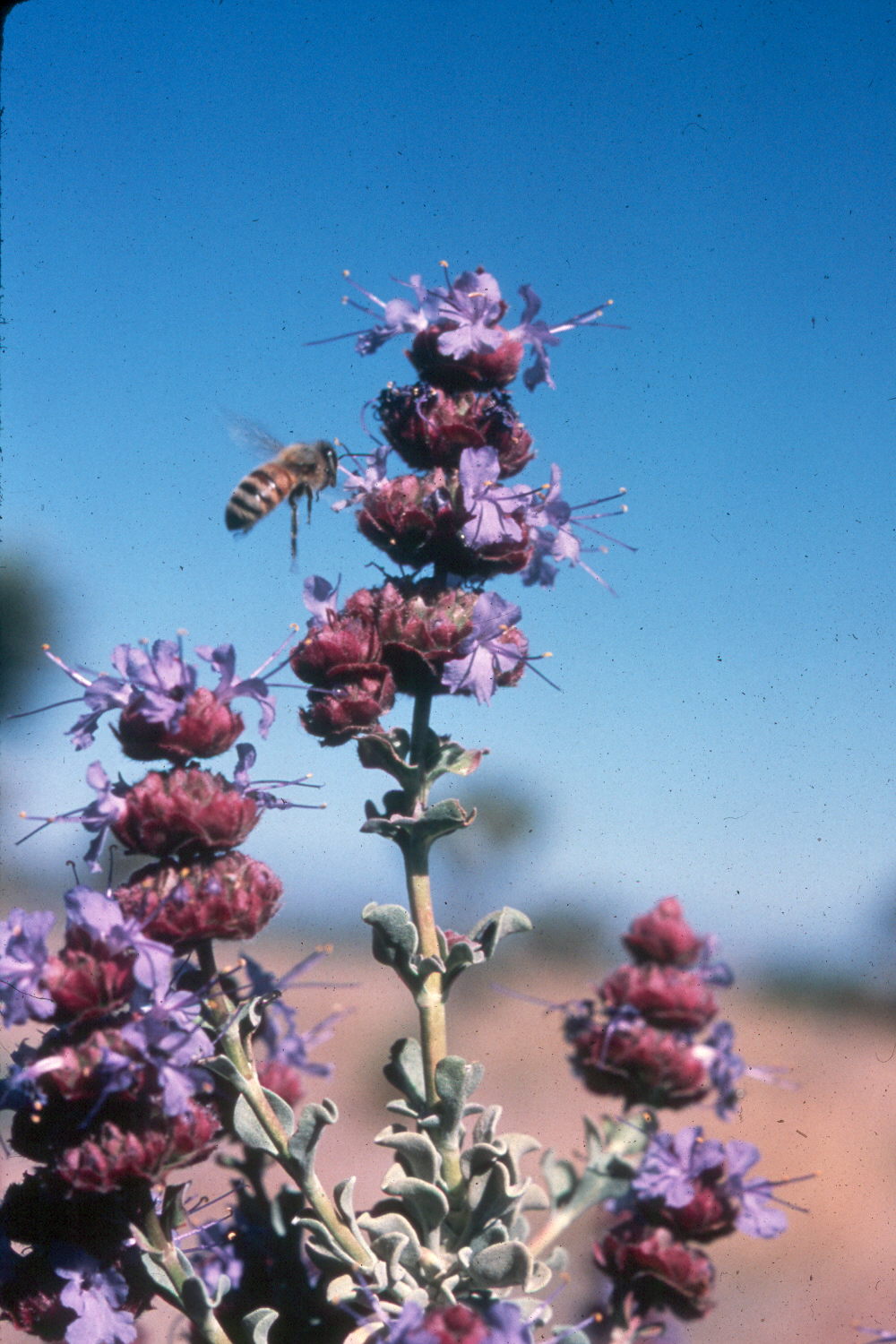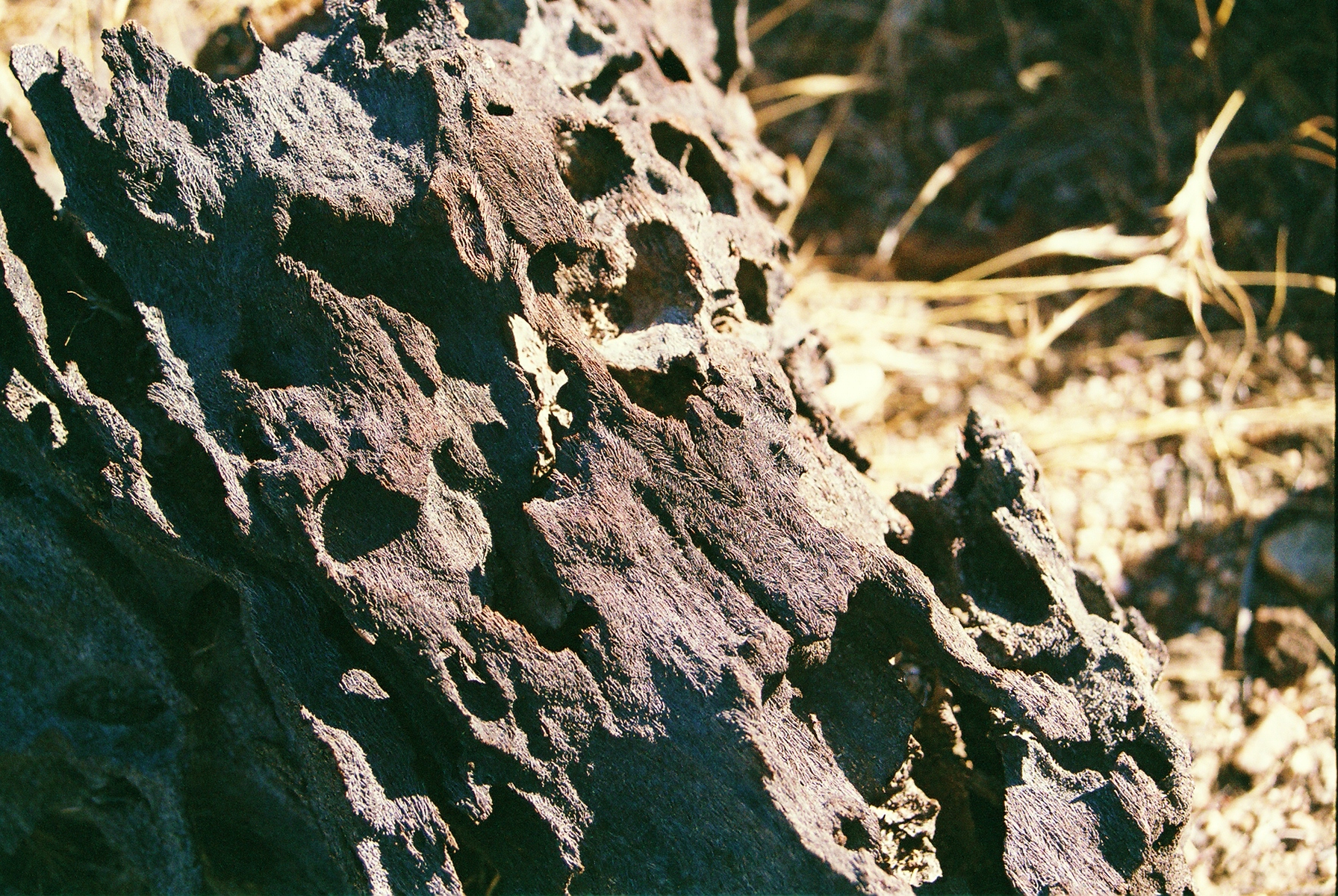The Nature Trail has black and white numbers on posts.
Text by Milt Stark
WELCOME to Arthur B. Ripley Desert Woodland State Park. On this 560-acre site, you will find a prime example of a virgin Joshua tree and California juniper forest.
Except for the non-native annual grasses that have replaced much of the native bunch grasses, this is how the western part of the Mojave Desert likely appeared to early explorers such as Pedro Fages (1772), Father Garcés (1776), or John C. Frémont (1848) as they ventured through the area.
This habitat is unique in that it is a transition area between desert and mountain climates, resulting in a mix of plants that are usually not found together. Joshua trees and California junipers are the dominate species of plants, with a large undergrowth of California buckwheat, golden bush, Mormon tea, blue sage, and beavertail cactus.
In the spring following a wet winter, many annual species such as chia, rock cress, golden gilia, filaree, goldfields, coreopsis, fiddleneck, blue dicks, pennyroyal, vinegar weed, and scarlet bugler bloom throughout the park.
The park is named for Arthur Ripley (1901-1988) who willed the property to the State. As a farmer, he cleared and farmed a large amount of acreage in the western part of the Antelope Valley, but he also was concerned enough about the Joshua/juniper woodlands to leave this area in a pristine state.
.jpg) |
| Arthur B. Ripley, farmer and Shriner |
Please follow the numbered posts beginning to the left of the information boards:
1. Flowers
In the spring, Joshua trees may form pineapple-shaped flower buds. Other flowers that bloom in this area are tidy tips, combs bur, filaree, fiddleneck, sun cups, silver puffs, and comet blazing stars. California buckwheat bushes form white flower clusters around May, which mature to a red-brown color.
.jpg) |
| Joshua Tree flower bud |
2. Animal Trails
As you walk through the park, look around you for the many animal trails, which have been established over hundreds of years.
The most common animal you might see on your walk is the black-tailed jack rabbit and sometimes a cottontail rabbit. Other creatures in the park are: woodrats (also called pack rats), Antelope ground squirrel, coyotes, ravens, kangaroo rats, the meadow mouse, roadrunners, king snakes, rattlesnakes and mourning doves.
.jpg) |
.jpg) |
| Black-tailed Jackrabbit | Cottontail Rabbit |
3. California Junipers
Junipers (Juniperus californica) with cones are male, whereas the ones which have berries are female. However, these junipers have been observed to change sex!
The bluish-green berries will take a year and a half to mature, and is food for birds and rodents. Coyotes eat them, but they seem to pass through without being digested. As you look around, you will see very few small junipers. The seeds in the cones are very difficult to germinate. Passing through a coyote's digestive tract helps to trigger germination.
More information about the peculiarities of the park’s junipers can be found by walking the “Rare Juniper Trail” with its brochure.
 |
| California Juniper |
4. Blue Sage
The silver-leaved shrub to the right of the numbered post is blue sage (Salvia dorrii). This plant is very fragrant, especially in the spring and during rain showers. The blue flowers grow on tall spikes during spring months. This plant belongs to the mint family, which all have square stems.
A close relative, also in the mint family, is the annual chia; dead stalks of which may be seen in many places along the walk throughout the year. Look for 10- to 18-inch-high stalks with two round pods, one of which the stalk grows through.
 |
| Blue Sage |
.jpg) |
| Chia |
5. Joshua Tree Reproduction
Note the small Joshua trees (Yucca brevifolia var. herbertii) in front of you. These may have germinated from seed, but more likely clones sprouted from the underground rhizomes of a mother tree. Although Joshua seeds germinate fairly easily, most of the seeds are eaten by birds, animals, or the larva of the pronuba moth which pollinates the blossom.
6. Joshua Trees
Probably no other tree grows in such grotesque forms as does the Joshua. The herbertii variety prefers deep sandy soil and rarely reaches more than 14 feet tall.
Also note that as the green spiked leaves die, they turn grey and fold down against the branch or trunk. As the tree ages, they fall off, leaving a bark-like covering.
The age of the slow-growing Joshua is unknown. Recent studies show that may live about 200 years, while some botanists believe it is much longer. As plants, the trunk does not have annual growth rings to indicate age, but rather contain a fibrous material like a palm tree.
7. Petrified Yucca
The pieces of wood on the ground in front of you are called petrified yucca. Some of this material is quite dense, and very heavy. Noted botanist Edmund Jaeger wrote about this material, “The so-called petrified wood, much prized as fuel by desert settlers, is made by the plant as it lays down silica in the cell walls in its attempt to wall off the injuries done by the borers, by fire, or by wind.”
The rest of the dead Joshua tree is very light weight and fibrous.
Remember, all natural and cultural features of the park are protected by law, and must be left in their place.
 |
| Petrified Joshua "wood" |
8. Beavertail Cactus
The beavertail cactus (Opuntia basilaris), is one of two cacti species which are native to the Antelope Valley. In the spring, these plants produce very showy, magenta colored flowers up to three inches across. The wine-colored fruit was eaten by the American Indians and makes an excellent jelly.
As you walk to the next point of interest, take a look at the Tehachapi Mountains to the north (to the left) of the path, rising to an elevation of 7,988 feet. They are the southern end of the Sierra Nevada Range and separate the San Joaquin Valley from the Antelope Valley. One of the original spellings of the name was “tehichipi”, presumably an American Indian word, or at least the way the settlers spelled the Yokuts Indian word, but the Southern Pacific Railroad changed the name to its present spelling.
On the right of the path, observe the dead juniper in stark contrast to the living trees.
9. Cryptogamic Crust
If you look closely at the ground to the left of the post, you will see small black spots on the earth which, when wet, look like black moss. These are “cryptogamic crusts” formed by cyanobacteria, the oldest form of life known. The sheaths formed by the cyanobacteria give the soil great stability and tensile strength and enhance resistance to erosional forces such as wind and water, as well as hide moisture and nutrients to be used by desert shrubs.
10. Juniper Uses
Junipers were cut by early settlers for firewood and fence posts. Even today one can find a few of these posts still standing, as they resist decay almost as well as redwood. When the wood is cut, a distinctive cedar smell is present. Check out the juniper stump to see the shape of the growth rings where the limbs were cut.
If you look under the juniper bush, you may see openings to animal burrows. Look under the live juniper to the right; the large pile of twigs is a wood rat's nest, or "midden." There are many middens throughout the park; see how many you can spot. But please, do not disturb anything.
 |
| Wood rat, aka pack rat |
11. Blue Elderberry Tree
The large bushy tree in front of you is a blue elderberry tree (Sambucus nigra ssp. caerulea), growing somewhat out of its usual range of the canyons and foothills to the south.
The berries are eaten by birds and small animals, or are made into a jelly by humans. Early Europeans believed that the witches lived in the elder trees.
12. Mormon Tea
The large groups of green plants with thin stems and no apparent leaves are Mormon tea (Ephedra nevadensis). In the spring they do have insignificant leaves. The male plant will have orange stamen-like growths from the nodules, while the female plant will produce small green cones. The local American Indians, the Kitanemuk, made a tea from the plant which was used to treat upper respiratory problems. They would also place bunches of the plant in the springs to sweeten the water.
As you return to the picnic area, look to your left toward a large field of grey-green shrubs. These are rabbit brush (Ericameria nauseosa), an early-stage recovery plant that began growing after the field was last planted with grain in 1971. During the fall months, these shrubs are covered with yellow blooms.
California State Parks is replanting the field in Joshuas and junipers in order to help restore it to its original state.
We hope you have enjoyed your walk through this Joshua tree/California juniper woodland. You may also enjoy the 1-mile "Rare Juniper Trail," which starts about 1/4 mile down the Nature Trail.
Revisit Arthur B. Ripley Desert Woodland State Park any time of the year; it is a new experience each season.
